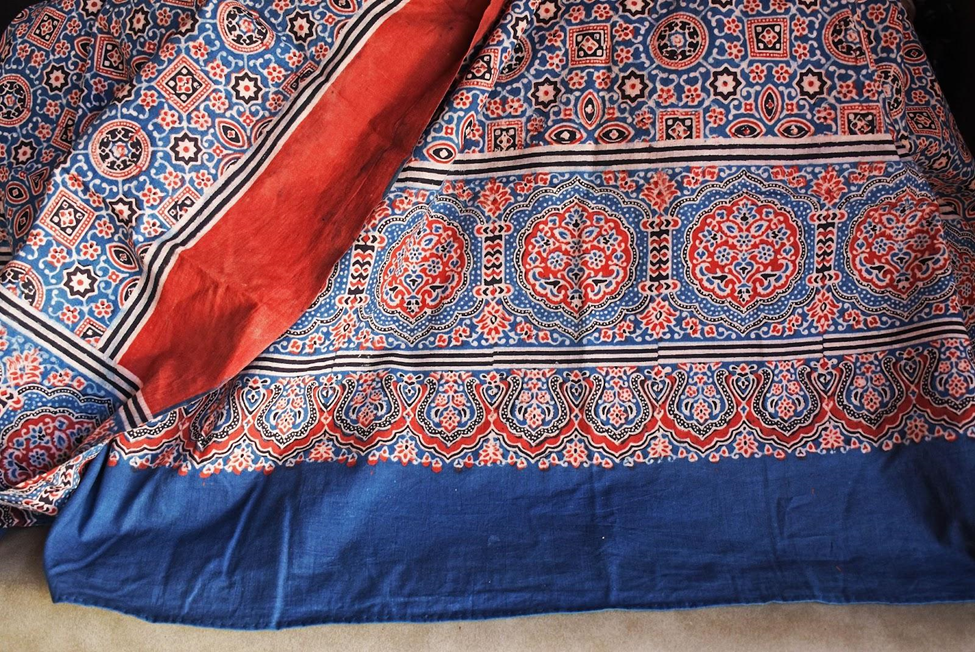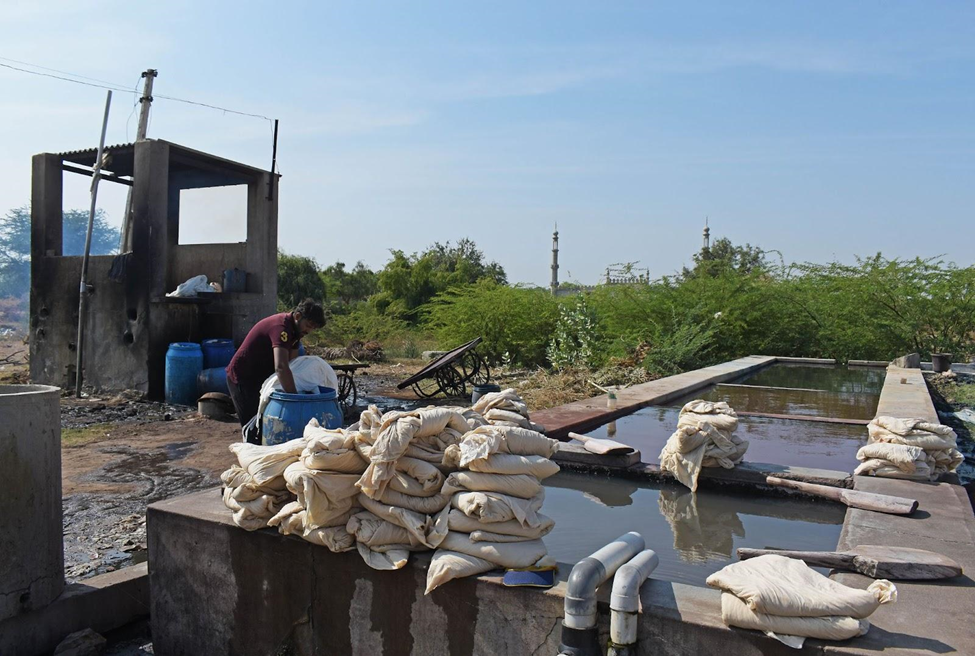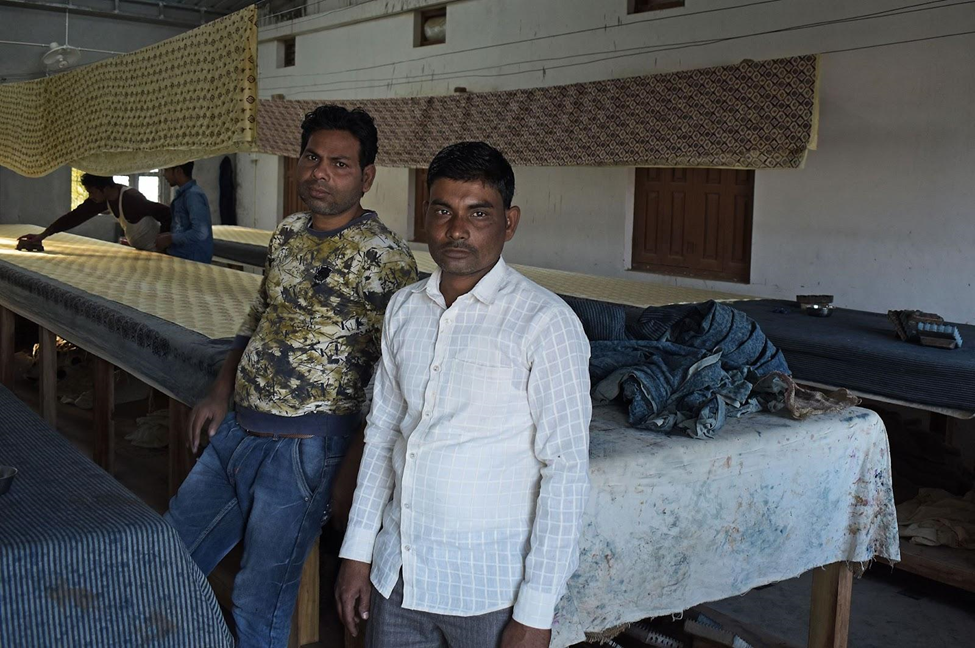How Ajrakh's Rising Demand Has Changed the Dynamics of the Tradition Behind the Art
Two small villages located in Gujarat's Kutch are continuing a craft that is rich in both history and tradition. Ajrakh, with a lineage from the Sindhi culture, is a cloth printing method which is traditionally done by printing blocks. It has more recently evolved to take the form of screen-printing to meet global demands of a cheaper alternative. From sarees, dupattas, and basic cloth material, Ajrakh is a versatile hand block printing art.
The craft’s vibrant and distinctive aesthetic value has been widely recognised across spaces, increasing its market demand, and consequently changing the dynamics of the tradition behind the art itself. The Centre for New Economics Studies’ Visual Storyboard team spent a couple of months in the areas across Bhuj – from Dhamadka to Ajrakhpur (a drive of 40-50 minutes ahead from Dhamadka) – where this artistic craft and the rich tradition of its production is rooted.
Initially, the practice was restricted to the Dhamadka village in Bhuj and has been largely undertaken by the trading community of the Khatris (washerfolk) across generations. The catastrophic effect of the 2001 earthquake in Bhuj and the imminent water crisis prompted the craft production to expand beyond Dhamadka to Ajrakhpur. Prior to this, the Khatri community, predominantly Muslims, faced a multitude of issues related to access to clean water, which is one of the most important resources for the craft’s production process.

An Ajrakh print on cotton fabric at Ajrakhpur in Kutch district, Gujarat. Photo: Jignesh Mistry
Extrapolating from Bhuj’s expansive geography, history, and kaleidoscopic myriad of craft/art-based livelihoods for communities, the Ajrakh hand block print possesses an unparalleled opulence and is rich in its context.
Ismail Khatri, one of the many people working on the Ajrakh craft, expands on the logic behind its unique printing style and colours. "For example, farmers won't wear green. Since they work in green fields, it will be difficult for their children to find them when they wake up from their sleep."
After living through countless booms and busts in demand, Ajrakh print products have continued to be well-received in the market, domestically and internationally (across Europe in particular). This is mainly attributed to the Khatri community’s adaptability to changing geo-spatial conditions, negotiating timely government assistance over years, and inter-generational practice that shapes the evolution of the craft.
Also read: The ‘Cutesy’ Indian Fabric That Changed History
A ‘life cycle’ approach to studying the craft
The process of Ajrakh block printing constitutes 12-14 steps, including making the block, preparation of the cloth, preparation of dyes, imprinting the design, and drying. Our team employed an ethnographic, life cycle approach to carefully study each step and process of the craft’s production function and the role of the community involved.

Traditional Ajrakh hand block design carvings in Dhamadka, Gujarat. Photo: Jignesh Mistry
The first step in the printing process is the making of the block. Initially, blocks were made at the workshops by special master craftsmen. However, as the demand for Ajrakh prints rose, the Khatri community outsourced block-making. Now, they buy readymade blocks from Pethapur and Gandhinagar.
The second step is the preparation of the cloth. The cloth is sourced from textile mills across the country. Before the cloth is ready to be imprinted, it is dipped into alum paste, washed, and then dried to remove its starch content.
The next step is the preparation of dyes. The Khatri community members has used natural dyes since the inception of the craft. These dyes have been made using a wide spectrum of natural substances, including harde (myrobalan), kaat (iron rust), chana no lot (chickpea flour), chuno (limestone), indigo, and pomegranate. To colour the cloth, it is boiled in water with different natural extracts, depending on the shade and texture.

A worker prepares cotton cloth for boiling after a wash at Dhamadka in Gujarat. Photo: Jignesh Mistry
Then the blocks with designs are dipped into the dye and imprinted on the cloth repeatedly until the entire cloth is covered. This process involves at least three craftsmen who work on one cloth simultaneously. Finally, the cloth is dried in the sun, and then ironed and stacked into piles.
Ajrak’s nomenclature originates from ‘Azrak’, meaning indigo, a well-known substance most often employed as a powerful dye to achieve a bluish effect. Ajrakh prints have traditionally consisted of three colors: blue which signifies the sky, red which signifies the land and the fire, and white which signifies the stars. The monopoly of these colours is reflected in the designs, and it is what lends Ajrakh its distinctive quality.
Initially, the motif was of a trifold flower that denoted the conglomeration of the sky, land, and water. Now, artists employ various kinds of motifs inspired by their cultural life, including makodo (insect), mor (peacock), champakali (flower), and chakli (sparrow). Furthermore, given changes in consumer tastes, traditional Ajrakh designs have been adapted to suit contemporary sensibilities, including the incorporation of motifs like ‘jaal’ and ‘booti’.

Workers dye cotton cloth in Harde (myrobalan) at Dhamadka in Gujarat. Photo: Jignesh Mistry
A significant change in the Khatri community’s role in the craft is the shift from hands-on production to knowledge dissemination. Due to the increase in demand for Ajrakh prints, much of the Khatri community is no longer as directly involved in the hands-on production of the crafts.
A lot of the work can now be seen as part of a shared responsibility with migrant workers employed by the community from parts of Uttar Pradesh, Bihar, Chhattisgarh, whose hands are often stained red from the dyes used in hand block printing. Instead, the Khatri community’s role has shifted to a more entrepreneurial role engaged in the large-scale commercialisation and the transfer of knowledge of the craft.

Dyed fabric dry on the bamboo rack at Dhamadka, Gujarat. Photo: by Jignesh Mistry)
The role of knowledge transfer and the youngsters in the Khatri community
Traditionally, older craftsmen in the Khatri community have passed down their knowledge and skill set directly to younger generations as opposed to through the channels of formalised procedure and institutions. This intergenerational transfer of the craft’s nuances has continued for decades, showing no signs of abatement, with the younger interviewees all equally interested in learning the craft, as well as teaching it to their children.
Interviewees from our study showed a preference for working in printmaking as opposed to searching for other forms of work, due to its historic and social importance in the community, as well as the job security and housing that it offers.
Another common theme that emerged during the interviews was a desire for skilled education among the interviewees, so that they could promote their craft and it could reach a wider audience. Improved access to knowledge on technological use and adoption, along with an entrenchment of financial literacy tools, remains a deeply valued need among the young (and old) members of the community.

Young workers engaged in the Indigo dyeing and drying process at Dhamadka, Gujarat. Photo: Jignesh Mistry
Ajrakh demands a high level of skill and knowledge of the intricacies of the craft. None of the interviewees (those randomly sampled) were educated beyond Class 10 in our study. However, the lack of formal education does not have a detrimental effect on the specialised knowledge displayed by the interviewees.
Some of the workers did learn bookkeeping and accounting as and when their job demanded them to (only if they had money to access these knowledge domains through private education). One interviewee had also taken a course on colours and designs from Kala Raksha, a social enterprise that aims to preserve traditional arts. This respondent went on to say that this course invigorated them with confidence to set up their crafts in exhibitions and other public forums.
The migrant population of Ajrakhpur
A vast majority of Ajrakhpur comprises a resettled population that arrived in waves after the devastating effects of the 2001 earthquake in Gujarat. Most of the business owners, who belong to the Khatri community, moved from their native village of Dhamadka after the earthquake made it uninhabitable. Some of them still have their families living and working in Dhamadka.
Abdul Raouf said, “Dhamadka was very homely when we lived and worked there. In contrast, Ajrakhpur feels like an industrial area and is all about the marketability of Ajrakh. When we visit Dhamadka, we feel more connected with our craft and do not feel like it is work.”
He also said, “In Dhamadka, we had easy access to labour. Many people from local villages used to work in our workshops. However, in Ajrakhpur, there aren’t many locals working. This is the reason there is a large number of migrants working for us.”

Hand block printers Naseemuddin and Mohammed Shafiq from Bharat Ganj, Allahabad district, Uttar Pradesh, at a workshop in Ajrakhpur, Gujarat. Photo: Jignesh Mistry)
Most of the labourers in Ajrakhpur’s workshops moved in search of work. They mostly receive wages per piece, with some of them also working as daily wage labourers. There is a multitude of reasons for the movement to Ajrakhpur, including better employment opportunities and better income to sustain their families.
A substantial number of labourers had moved to Ajrakhpur from Bharatganj, Allahabad, after workshops began shutting down due to lack of access to markets and vendors, and a drop in demand. These labourers, who had grown up learning printing and dyeing, found the work in Ajrakhpur to be regular and sufficient, because of a higher market demand.
The need for migrant labours arose in Ajrakhpur because a large number of people from the Khatri community moved out of this trade. This mass outward migration took place because of a steep drop in demand for Ajrakh cloth with the rise in accessibility to cheaper alternatives.
Many youngsters in the community migrated to Mumbai in search of better economic opportunities. This gap in the labour force in the Ajrakhpur workshops was now filled by young migrants, who moved there in search of regular work. Migrant workers learnt the craft on the job, and workshop owners provided them accommodation and other essential facilities within the workshop spaces.
Over the course of the interviews, the migrants also displayed satisfaction with their work and explained that they preferred to stay within the workshops. Their living conditions, however, were very dismal.

Migrant hand block printers work on a piece of fabric at a workshop in Ajrakhpur, Kutch district, Gujarat. Photo: Jignesh Mistry
Also read: Handlooms Are Dying – And It’s Because of Our Failure to Protect Them
The role of the State and the needs of the community
One of the most important resources for the Ajrakh craft has been water. It has been a contested resource since the early 1900s.
Since the Kutch area has a desert climate, rainfall is minimal throughout the year. This did not pose as a problem till 1990, when the sole river in the area dried up due to excessive borewell use. Jabbar Khatri elaborated on the struggle, “Despite the scarce availability of water, the demand for Ajrakh didn't fall. To keep up with this demand, my father bought new land and dug wells. But this extracted water had larger iron content, so we had to find a solution to that as well. So, we naturally filtered iron from the water using charcoal, concrete, etc."
Due to the requirement of essential resources like water, the community works in tandem with the Gujarat government. The state government has built water filter plants to ensure judicious use of water (post the multiple instances of extensive use) and has also provided a relief fund of Rs 50,000 when the devastating earthquake had struck Gujarat in 2001.

Washing area next to the water recycling plant at Ajrakhpur. Photo: Jignesh Mistry
Apart from the disaster relief fund, the state government had also stepped in when there was a need to create demand. The market demand for Ajrakh had fallen due to lack of access to the city, and the emergence of fast fashion and cheaper alternatives. The Gujarat State Handloom and Handicrafts Development Corporation, an organisation set up by the state government, intervened and bought cloth directly from artisans. Using a model similar to the minimum support price, the governmental organisation sold the cloth in the market.
This was initially met with protests despite the negative effects of chemical colours which had been taken up in the 1970s due to a rising demand for low-priced Ajrakh. One interviewee even said, "In my father’s time, there weren't many facilities or access to the village, so the community was hesitant to cooperate even when we said it was a government initiative. Even after the presence of the government increased, we used to work in our traditional manner and didn't care for the lack of different colours in the print. But the organisation wished for us to train and expand."
After this contested training, the Ajrakh colour set has expanded from the initial figure of six to 35. The Khatri community has come a long way from making an identity through their clothes to adapting and learning methods from other communities. In many ways, the government has contributed to the persistence of the craft.
Ajrakh is not just a craft of economic value. It acts as a unifying factor that brings together families of various classes and religious backgrounds. It possesses a symbolic value of the cultural economy of India and reflects the country’s unique creative arts landscape, culture, and traditional heritage.
The craftsmen (mostly men) of Ajrakhpur have had to face the brunt of many ecological issues. Additionally, they had to face multiple changes to the Ajrakh trade due to changing market dynamics and a globalised economy, which is increasingly commodifying the craft, thereby erasing its vibrant distinctiveness.
The upliftment of the craftsmen of Ajrakhpur can only possibly arrive with a shift in strategy in the way in which the Ajrakh cloth is viewed, from a commodity to an end product that is the result of hours of intricate effort.
Deepanshu Mohan is associate professor of Economics and director, Centre for New Economics Studies (CNES), Jindal School of Liberal Arts and Humanities, O.P. Jindal Global University.
Jignesh Mistry is a photojournalist and a senior research analyst, Visual Storyboards Team Lead with CNES. Shubhangi Derhgawen is an independent researcher, journalist and a contributing research analyst to Visual Storyboards.
Hima Trisha, Ashika Thomas, Tavleen Kaur and Yashasvini Gupta are all research assistants with CNES.
All photo credits belong to Jignesh Mistry.
This story is produced by the CNES Visual Storyboard Team, Jindal School of Liberal Arts and Humanities, OP Jindal Global University. See its website here for access to previous field stories and to support the initiative, please check the fundraising section. Video essays from this visual story are published here.
The authors would like to thank Abdul Raouf, Jabbar Khatri and Ismail Khatri, from Ajrakhpur and Dhamadka areas who helped the team get access to the life stories of Khatri community workers engaged in Ajrakh hand block printing work. For any inputs/comments on the story, please write to CNES team at cnes@jgu.edu.in.
This article went live on January twenty-second, two thousand twenty three, at zero minutes past one in the afternoon.The Wire is now on WhatsApp. Follow our channel for sharp analysis and opinions on the latest developments.




